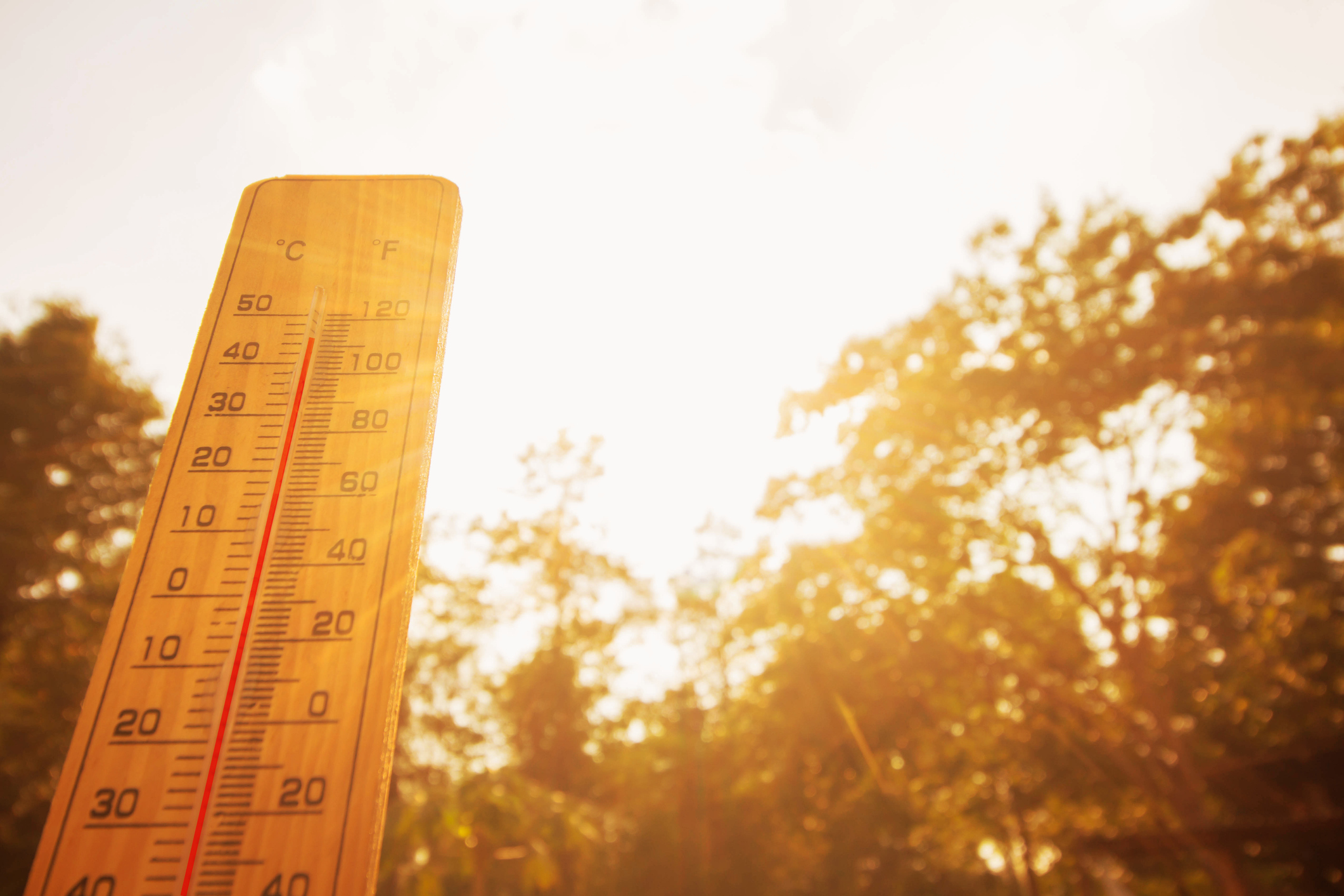Keeping Playgrounds Cool: Designing for Thermal Safety
Posted by May Recreation Content Team on

Keeping kids cool, comfortable and protected on the playground can be a year-round task in Texas where not just the summers bring plenty of sunshine and serious heat.
“Summer starts off hot, then cools just enough to fool you. That brief relief is what Texans call 'fake fall' — don’t fall for it. What comes next is the wrath of the sun,” explains Amarillo’s Mix 94.1.
In other words: outdoor play in the Lone Star State rarely gets a real break from the heat. And while time outside is essential for children’s physical, emotional, and social development, the risk of contact burns from overheated playground equipment and surfacing is a real and preventable safety concern.
From slides that can reach scorching temperatures to dark rubber surfacing that trap radiant heat, playgrounds can quickly become uncomfortable — or even hazardous — when temperatures climb.
For parks departments, HOAs, and schools, understanding playground heat safety and designing with thermal comfort in mind is critical to keeping play areas safe and accessible year-round.
Understanding the Risk: How Hot Is Too Hot?
Children’s skin is more sensitive than adults’, and it takes just seconds for a burn to occur on overheated surfaces. Studies show that when air temperatures reach 90°F, some playground surfaces can exceed 140°F—with contact burns possibly occurring in one to three seconds.
Surface temperature varies widely depending on material type, color, and sun exposure:
| Material | Surface Temp @ 90°F Air | Burn Risk |
| Metal slide | 160–180°F | Burn in under 2 seconds |
| Dark plastic slide | 150–160°F | Burn in under 3 seconds |
| Light plastic slide | 120–130°F | Use caution |
| Black rubber surfacing | 140–150°F | High burn risk |
| Light-colored rubber surfacing | 110–120°F | Generally safer |
| Engineered wood fiber | 100–110°F | Lower risk |
(Data compiled from ASTM and CPSC research on playground surface temperature variations.)
While metal equipment used to be the biggest concern, modern plastics and rubberized surfaces can also become dangerously hot under direct sun exposure—especially in Southern states like Texas, where ambient heat and UV intensity peak during summer months.
“The Consumer Product Safety Commission says one child was burned when it was just 74 degrees,” reported an August, Ga. television station. “It’s not just the metal slides you need to worry about. We found the plastic used for slides, swings and even the ground surfaces can all burn children if you aren’t careful.”
How Color and Material Affect Playground Surface Temperature
Color choice plays a major role in heat retention. Darker hues—black, navy, deep green, or burgundy—absorb more sunlight, while lighter colors reflect it.
For example:
- A black rubber surface may reach 150°F in direct sun,
- while a light tan or pastel surface under identical conditions might remain below 120°F.
That 30°F difference can mean the difference between safe play and serious injury.
When selecting equipment and surfacing, opt for light, reflective colors such as beige, light blue, tan, or pale green. These not only lower surface temperature but also create a visually cooler, more inviting environment.
In addition to color, the material composition matters:
- Metal conducts heat rapidly and stays hot longer.
- Plastic absorbs heat more slowly but can still reach high temperatures.
- Wood and composite materials tend to remain cooler, though they may require more maintenance.
- Engineered wood fiber (EWF) (and certain synthetic turf) with infill designed for thermal comfort can be significantly safer than older surfaces – though it must meet safety specs for depth and maintenance to remain effective.
Designing for Thermal Safety: Practical Solutions
Preventing contact burns and overheating isn’t just about material selection— it’s about smart design and site planning. Thoughtful placement, shading, and surfacing strategies can drastically reduce heat exposure.
Here are key principles for designing heat-safe playgrounds:
-
Incorporate Shade Structures and Natural Shade
Shade is the single most effective way to reduce surface temperature. Studies show shaded play areas can be 20–30°F cooler than those in direct sunlight.
Options include:
- Integrated fabric shade canopies over slides, decks, and climbers
- Freestanding pavilions or gazebos for gathering areas
- Tree planting to create natural shade and cooler microclimates
May Recreation offers a range of custom shade structures that blend seamlessly with play systems while maintaining sightlines and airflow.
-
Use Lighter, Reflective Colors
Select lighter colors for both play structures and surfacing materials.
Avoid dark greens, blacks, and reds in favor of light blues, grays, and tans. Not only do these shades reflect more sunlight, but they also create a more cheerful and open atmosphere.
-
Orient Equipment Strategically
Consider the sun’s daily path when placing slides, climbers, or decks.
South- and west-facing equipment receives the most intense afternoon heat. Position slides to face north or east whenever possible to minimize exposure.
-
Mix Surfacing Materials for Function and Comfort
Use a combination of cooler surfacing materials in high-traffic zones.
For example:
- Place engineered wood fiber (EWF) or coated turf beneath slides and swings.
- Use light-colored poured-in-place rubber for ADA accessibility and impact attenuation.
- Avoid dark rubber tiles or asphalt in full-sun areas.
-
Include Rest and Hydration Areas
Kids (and caregivers) need breaks from the heat. Add benches under shaded structures, drinking fountains, and pavilions nearby for rest and cooling down.
-
Regular Maintenance and Temperature Monitoring
Thermal comfort isn’t “set and forget.” Schedule periodic surface temperature checks during summer months and document readings as part of your playground’s safety inspections.
Replace faded or cracked surfacing and consider upgrades to cooler materials as technology improves.
Educating the Community About Heat Safety
Even with the best design, community awareness is key. Post simple, friendly signage reminding caregivers to:
- Test surfaces before allowing children to play (“Touch before they slide”)
- Encourage hydration breaks
- Avoid play during peak sun hours (typically 10 a.m. – 4 p.m.)
Regular communication through social media or newsletters can also help promote playground heat safety awareness, especially during heat advisories:
- When possible, reference heat index values or local advisories in communications to provide timely, actionable guidance for families.
- Remind readers that weather conditions can change quickly, so checks and caution are always necessary, even outside posted peak hours.
The Bigger Picture: Beyond Mere Compliance
Playground standards like ASTM and CPSC primarily focus on impact safety and materials, which are essential— but thermal safety is often a secondary consideration in official codes.
For families in hot climates such as Texas, the ability to use playgrounds comfortably year-round often depends on how well these spaces mitigate sun and heat.
By prioritizing shade, specifying lighter colors, and selecting materials engineered for lower surface temperatures, communities create playgrounds that are inviting and comfortable in every season— not just the mild ones. This thoughtful approach leads to greater usage, safer play, and a higher return on your investment in play equipment.
Building Cooler, Safer Playgrounds with May Recreation
For more than 40 years, May Recreation has helped schools, parks, and developers across Texas design playgrounds that balance creativity, safety, and comfort. Their expertise includes not only equipment selection and installation but also guidance on heat-safe materials, surfacing, and shade integration.
Whether you’re upgrading an existing playground or planning a new one, May Recreation can help you select products engineered for thermal comfort—from UV-stabilized slides and light-colored surfacing to custom shade structures that protect the play experience all year long.
Contact May Recreation today to learn more about playground shade, surfacing, and material options that maximize safety and year-round usability.
